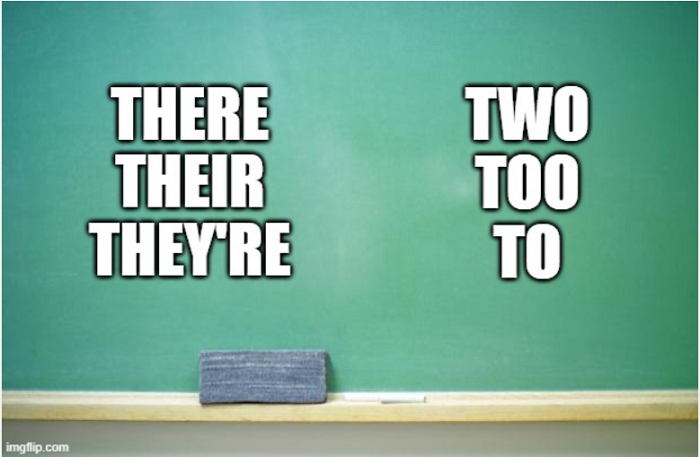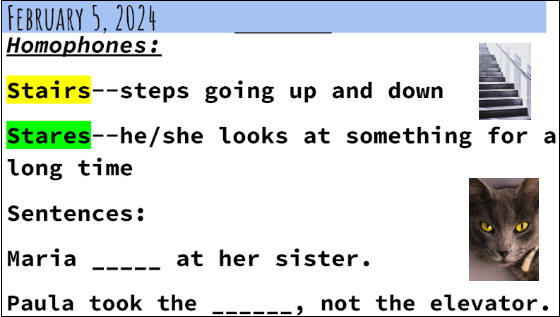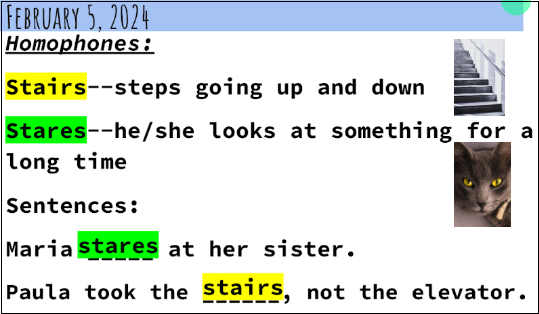- MN ABE Connect
- Archive
- Homophones in Isolation for the Adult Learner
 May 6, 2024
May 6, 2024
Homophones in Isolation for the Adult Learner
Kim Sombke, ELL Instructor“To isolate or to contextualize?” That is the question. Grammar, vocabulary, sentence mechanics, homophones–all can be taught contextually in the ELL classroom, or, when isolated, we allow time and space to slow down and be even more intentional in instruction.
Truly, homophone lessons are appropriate and needed in most areas of adult learning–including test preparation and high school equivalency.
Over a handful of years, I’ve built a homophones curriculum for my low-intermediate EL learners (and I’m sharing it all below in case it fits your classroom, too). Through it, routines are established, the pace is controlled, and the objective is intentionality because homophones are here (hear), there (their/they’re), and everywhere (wear)!
Daily homophone lessons
Adult language learners often wrestle with homophones as texts and conversations are littered with them. Homophone curricula are difficult to find, and they often consist of simple lists–without a lens, without activities, and usually without examples. This curriculum (that I am providing access to below) consists of bell-ringer-type homophone lessons intended for the start of my classes daily. They are organized into monthly slideshows–nine to date.
When presenting the daily slide with 2 (two) or possibly 3 (too, to) homophones, we take time to attempt pronouncing the new homophones. Then we read the words and definitions together, view pictures, and oftentimes translate the homophones.
Here’s one slide example:
The slides were designed with animated answers in the sentence examples. By clicking through the above slide, the green stares will “push” into the sentence about Maria, and the yellow stairs will subsequently “push” into the sentence about Paula. Pictures are helpful, too, as students may be learning new vocabulary in addition to hearing and seeing the words as homophones.
Here’s the same slide with the answers pushed in.
Graphic organizer
Modeling how to record the homophones into a graphic organizer is next. Once upon a time, I asked students to log these lessons in their notebooks, but that lacked spatial continuity since students use their notebooks for numerous activities throughout the day. Asking them to have a separate notebook seemed cumbersome, so I formatted a template to print, copy, cut and staple into a homemade book. Using the book is a part of our daily routine in conjunction with the slides.
Notice that the template provides space to list and translate homophones vertically; moving horizontally, there is space for definitions, use in sentences, parts of speech to identify and an area to draw a picture. It’s okay to stumble through with stick figure drawings and simplistic examples–for me, it’s another opportunity for humility since I display my own copy with a document camera.
Also, I’m a big proponent of color-coding, so students have a yellow and a green highlighter, and we take time to highlight the homophones in the homemade, preformatted “book” to match the slides.
Reading and repeating the homophones in sentences takes time, but it’s a chance to practice pronunciation as well as sentence mechanics. Students even get excited when we later find the same homophones, contextualized (I’m definitely not opposed to contextualizing in general!).
Weekly quizzes
In addition to this daily lesson, lasting 15-20 minutes ordinarily, we review at the end of every week through Quizlet: a website (with an app) that provides opportunities for teachers to facilitate vocabulary lessons with audio through flashcards and a variety of activities. Teachers must create an account if they intend to make original lessons. (The free version is a great option!)
No account is necessary, however, to access the premade lessons shared with you here. Students and instructors only need the link to each review lesson. There are nine Quizlet links shared in the folder, one for each month, September through May. These match the nine slideshows.
Access the homophone curriculum!
The curriculum is housed in this shared Google folder:
Inside there are slideshows, the template to the homophone book, and a Google Doc that provides links to all Quizlet review lessons. You are welcome to make a copy of the folder or any of its contents to keep and use as you’d like. Just know that it is subject to change as class needs change on my end. Happy homophone hunting!

Newsletter Signup
Get MN ABE Connect—the official source for ABE events, activities, and resources!
Sign UpArticle Categories
- ABE Foundations/Staff Onboarding
- ACES/Transitions
- Adult Career Pathways
- Assessment
- CCR Standards
- Citizenship
- COVID-19
- Cultural Competency
- Digital Literacy/Northstar
- Disabilities
- Distance Learning/Education
- ELA
- Equity/Inclusion
- ESL
- HSE/Adult Diploma
- Listening
- Math/Numeracy
- Mental Health
- Minnesota ABE
- One-Room Schoolhouse/Multilevel
- Professional Development
- Program Management
- Reading
- Remote Instruction
- Science
- Social Studies
- Speaking/Conversation
- Support Services
- Teaching Strategies
- Technology
- Uncategorized
- Volunteers/Tutors
- Writing


